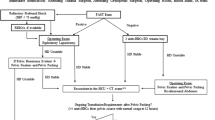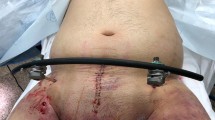Abstract
Patients with haemodynamic instability due to pelvic fracture-related bleeding can have life-threatening haemorrhage. Management options for haemorrhage control in complex pelvic fractures include bony stabilization, angioembolization, and preperitoneal pelvic packing (PPP). The indications for PPP as well as the operative technique and outcomes will be described in this review. PPP directly addresses the bony and venous bleeding of complex pelvic fractures, which results in the majority of blood loss in exsanguinating patients. As such, PPP should be considered for pelvic fracture patients who remain haemodynamically unstable despite red cell transfusion.

Similar content being viewed by others
References
Gustavo Parreira J, Coimbra R, Rasslan S, Oliveira A, Fregoneze M, Mercadante M (2000) The role of associated injuries on outcome of blunt trauma patients sustaining pelvic fractures. Injury 31:677–682
Demetriades D, Karaiskakis M, Toutouzas K, Alo K, Velmahos G, Chan L (2002) Pelvic fractures: epidemiology and predictors of associated abdominal injuries and outcomes. J Am Coll Surg 195:1–10
Jang JY, Shim H, Jung PY, Kim S, Bae KS (2016) Preperitoneal pelvic packing in patients with hemodynamic instability due to severe pelvic fracture: early experience in a Korean trauma center. Scand J Trauma Resusc Emerg Med 24:3–9
Heetveld MJ, Harris I, Balogh Z, Schlaphoff G, D’Amours SK, Sugrue M (2004) Hemodynamically unstable pelvic fractures: recent care and new guidelines. World J Surg 28:904–909
Lawson CM, Black EA, Smith S, Daley BJ (2010) Mortality after angioembolization in pelvic fractures: a ten year review. 69th Annual Meeting of the American Association for the Surgery of Trauma, Boston, MA
Sathy AK, Starr AJ, Smith WR, Elliott A, Agudelo J, Reinert CM, Minei JP (2009) The effect of pelvic fracture on mortality after trauma: an analysis of 63,000 trauma patients. J Bone Joint Surg Am 91:2803–2810
Smith WR, Williams A, Agudelo J, Shannon M, Morgan S, Stahel P, Moore EE (2007) Early predictors of mortality in hemodynamically unstable pelvis fractures. J Orthop Trauma 21:31–36
Starr AJ, Griffin DR, Reinert CM, Frawley WH, Walker J, Whitlock SN, Borer DS, Rao AV, Jones AL (2002) Pelvic ring disruptions: prediction of associated injuries, transfusion requirement, pelvic arteriography, complications, and mortality. J Orthop Trauma 16:553–561
Lunsjo K, Tadros A, Hauggaard A, Blomgren R, Kopke J, Abu-Zidan FM (2007) Associated injuries and not fracture instability predict mortality in pelvic fractures: a prospective study of 100 patients. J Trauma 62:687–691
Hauschild O, Strohm PC, Culemann U, Pohlemann T, Suedkamp NP, Koestler W, Schmal H (2008) Mortality in patients with pelvic fractures: results from the German pelvic injury register. J Trauma 64:449–455
Scalea TM, Stein DM, O’Toole RV, Feliciano DV, Mattox KL and Moore EE (2008) Pelvic fractures in trauma (ed), 6th edition, McGraw-Hill, New York, NY
Verbeek D, Sugrue M, Balogh Z et al (2008) Acute management of hemodynamically unstable pelvic trauma patients: time for a change? Multicenter review of recent practice. World J Surg 32:1874–1882
Perkins ZB, Maytham GD, Koers L, Bates P, Brohi K, Tai NR (2014) Impact on outcome of a targeted performance improvement programme in haemodynamically unstable patients with a pelvic fracture. Bone Joint J 96-B(8):1090–1097
Costantini TW, Coimbra R, Holcomb JB et al (2016) AAST pelvic fracture study group. Current management of hemorrhage from severe pelvic fractures: results of an American Association for the Surgery of Trauma multi-institutional trial. J Trauma Acute Care Surg 80(5):717–725
Tesoriero R, Bruns B, Narayan M, Dubose J, Guliani S, Brenner M, Boswell S, Stein DM, Scalea T (2017) Angiographic embolization for hemorrhage following pelvic fracture: is it “time” for a paradigm shift? J Trauma Acute Care Surg 82(1):18–26
Tai DKC, Li W-H, Lee K-Y, Cheng M, Lee K-B, Tang L-F, Lai AK-H, Ho H-F, Cheung M-T (2011) Retroperitoneal pelvic packing in the management of hemodynamically unstable pelvic fractures: a level I trauma center experience. J Trauma 71:E79–E86
Hou Z, Smith WR, Strohecker KA, Bowen TR, Irgit K, Baro SM, Morgan SJ (2012) Hemodynamically unstable pelvic fracture management by advanced trauma life support guidelines results in high mortality. Orthopedics 35:e319–e324
Thorson CM, Ryan ML, Otero CA, Vu T, Borja MJ, Jose J, Schulman CI, Livingstone AS, Proctor KG (2012) Operating room or angiography suite for hemodynamically unstable pelvic fractures? J Trauma Acute Care Surg 72:364–372
Biffl WL, Smith WR, Moore EE, Gonzalez RJ, Morgan SJ, Hennessey T, Offner PJ, Ray CE Jr, Franciose RJ, Burch JM (2001) Evolution of a multidisciplinary clinical pathway for the management of unstable patients with pelvic fractures. Ann Surg 233:843–850
Gonzalez E, Moore EE, Moore HB et al (2016) Goal-directed hemostatic resuscitation of trauma-induced coagulopathy: a pragmatic randomized clinical trial comparing a viscoelastic assay to conventional coagulation assays. Ann Surg 263(6):1051–1059
Pohlemann T, Gansslen T, Bosch A, Tscherne U (1994) The technique of packing for control of hemorrhage in complex pelvic fractures. Tech Orthop 9:267–270
Pohlemann T, Tscherne H, Baumgärtel F, Egbers HJ, Euler E, Maurer F, Fell M, Mayr E, Quirini WW, Schlickewei W, Weinberg A (1996) Pelvic fractures: epidemiology, therapy and long-term outcome. Overview of the multicenter study of the pelvis study group. Unfallchirurg 99:160–167
Ertel W, Keel M, Eid K, Platz A, Trentz O (2001) Control of severe hemorrhage using C-clamp and pelvic packing in multiply injured patients with pelvic ring disruption. J Orthop Trauma 15:468–474
Giannoudis PV, Pape HC (2004) Damage control orthopaedics in unstable pelvic ring injuries. Injury 35:671–677
Totterman A, Madsen JE, Skaga NO, Roise O (2007) Extraperitoneal pelvic packing: a salvage procedure to control massive traumatic pelvic hemorrhage. J Trauma 62:843–852
van Veen IH, van Leeuwen AA, van Popta T, van Luyt PA, Bode PJ, van Vugt AB (1995) Unstable pelvic fractures: a retrospective analysis. Injury 26:81–85
Huittinen VM, Slätis P (1973) Postmortem angiography and dissection of the hypogastric artery in pelvic fractures. Surgery 73:454–462
Smith WR, Moore EE, Osborne P, Agudelo JF, Morgan SJ, Parekh AA, Cothren C (2005) Retroperitoneal packing as a resuscitation technique for hemodynamically unstable pelvic fractures: report of two cases and description of technique. J Trauma 59:1510–1514
Burlew CC, Moore EE, Stahel PF et al (2016) Preperitoneal pelvic packing reduces mortality in patients with life-threatening hemorrhage due to unstable pelvic fractures. J Trauma Acute Care Surg 82(2):233–242
Burlew CC, Moore EE, Smith WR, Johnson JL, Biffl WL, Barnett CC, Stahel PF (2011) Preperitoneal pelvic packing/external fixation with secondary angioembolization: optimal care for life-threatening hemorrhage from unstable pelvic fractures. J Am Coll Surg 212:628–637
Marzi I, Lustenberger T (2014) Management of Bleeding Pelvic Fractures. Scand J Surg 103(2):104–111
Magnone S, Coccolini F, Manfredi R et al (2014) Management of hemodynamically unstable pelvic trauma: results of the first Italian consensus conference (cooperative guidelines of the Italian Society of Surgery, the Italian Association of Hospital Surgeons, the multi-specialist Italian Society of Young Surgeons, the Italian Society of Emergency Surgery and Trauma, the Italian Society of Anesthesia, analgesia, resuscitation and intensive care, the Italian Society of Orthopaedics and Traumatology, the Italian Society of Emergency Medicine, the Italian Society of Medical Radiology -section of vascular and interventional radiology- and the World Society of Emergency Surgery). World J Emerg Surg 9(1):18–25
Li Q, Dong J, Yang Y, Wang G, Wang Y, Liu P, Robinson Y, Zhou D (2016) Retroperitoneal packing or angioembolization for haemorrhage control of pelvic fractures--quasi-randomized clinical trial of 56 haemodynamically unstable patients with injury severity score >33. Injury 47(2):395–401
Osborn PM, Smith WR, Moore EE, Cothren CC, Morgan SJ, Williams AE, Stahel PF (2009) Direct retroperitoneal pelvic packing versus pelvic angiography: a comparison of two management protocols for haemodynamically unstable pelvic fractures. Injury 40:54–60
Schwartz DA, Medina M, Cotton BA, Rahbar E, Wade CE, Cohen AM, Beeler AM, Burgess AR, Holcomb JB (2014) Are we delivering two standards of care for pelvic trauma? Availability of angioembolization after hours and on weekends increases time to therapeutic intervention. J Trauma Acute Care Surg 76(1):134–139
Pohlemann T, Bosch U, Gansslen A, Tscherne H (1994) The Hannover experience in management of pelvic fractures. Clin Orthop Relat Res p 69–80
Cheng M, Cheung MT, Lee KY, Lee KB, Chan SC, Wu AC, Chow YF, Chang AM, Ho HF, Yau KK (2015) Improvement in institutional protocols leads to decreased mortality in patients with haemodynamically unstable pelvic fractures. Emerg Med J 32(3):214–220
Chiara O, di Fratta E, Mariani A, Michaela B, Prestini L, Sammartano F, Cimbanassi S (2016) Efficacy of extra-peritoneal pelvic packing in hemodynamically unstable pelvic fractures, a propensity score analysis. World J Emerg Surg 11:22–29
Author information
Authors and Affiliations
Corresponding author
Ethics declarations
Conflict of interest
The authors declare that they have no conflict of interest.
Funding
There is no funding source.
Ethical approval
This article does not contain any studies with human participants or animals performed by any of the authors.
Informed consent
N/A
Rights and permissions
About this article
Cite this article
Burlew, C.C. Preperitoneal pelvic packing for exsanguinating pelvic fractures. International Orthopaedics (SICOT) 41, 1825–1829 (2017). https://doi.org/10.1007/s00264-017-3485-3
Received:
Accepted:
Published:
Issue Date:
DOI: https://doi.org/10.1007/s00264-017-3485-3




